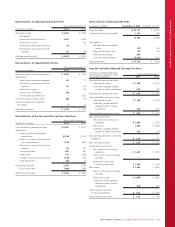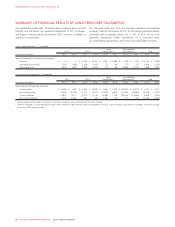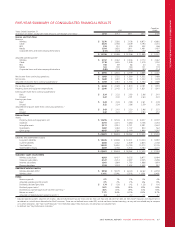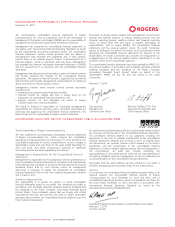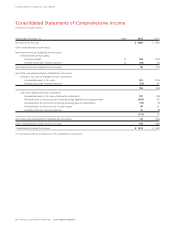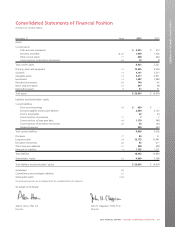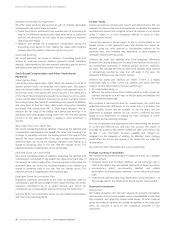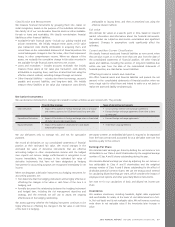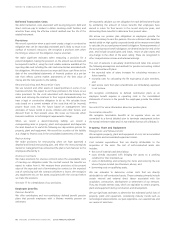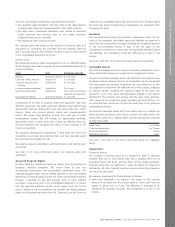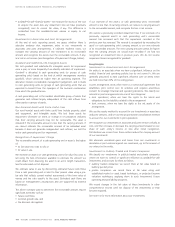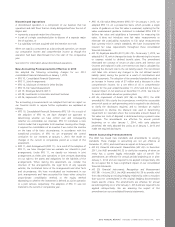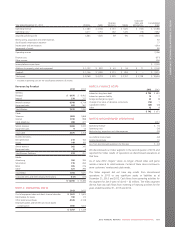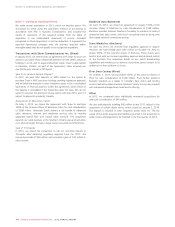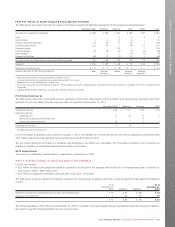Rogers 2013 Annual Report Download - page 99
Download and view the complete annual report
Please find page 99 of the 2013 Rogers annual report below. You can navigate through the pages in the report by either clicking on the pages listed below, or by using the keyword search tool below to find specific information within the annual report.
NOTES TO CONSOLIDATED FINANCIAL STATEMENTS
We also use significant judgment in the following areas:
• determining cash generating units and the allocation of goodwill for
the purpose of impairment testing (see note 13)
• choosing methods for depreciating our property, plant, and
equipment that we believe most accurately represent the
consumption of benefits derived from those assets and are more
representative of the economic substance of the use of the
underlying assets (see Property, Plant and Equipment, below)
• deciding to designate our spectrum licences as assets with indefinite
useful lives since we believe they are likely to be renewed for the
foreseeable future (see Goodwill and Intangible assets, below)
• interpreting tax rules and regulations when we calculate income
taxes (see note 27), and
• determining the probability of loss when we assess contingent
liabilities (see note 27).
Revenue Recognition
We recognize revenue when we can estimate its amount and are reasonably assured that we can collect it. Revenue is recorded net of discounts.
Source of revenue How we recognize it
Monthly subscriber fees for wireless, cable, telephony and Internet
services, rental of equipment, network services and media subscriptions
• Record revenue as the service is provided
Revenue from airtime, data services, roaming, long-distance and optional
services, pay-per-use services and other sales of products
• Record revenue as the services or products are delivered
Revenue from the sale of wireless and cable equipment • Record revenue when the equipment is delivered and accepted by
the independent dealer or subscriber in direct sales
Equipment subsidies related to providing equipment to new and existing
subscribers
• Record a reduction of equipment revenues when the equipment is
activated
Installation fees charged to subscribers in Cable • These fees do not meet the criteria as a separate unit of accounting
• We defer and amortize these fees over the related service period,
which is approximately three years
• In Business Solutions we defer and amortize fees over the length of
the customer contract
Activation fees charged to subscribers in Wireless • These fees do not meet the criteria as a separate unit of accounting
• We record these fees as part of equipment revenue
Advertising revenue • Record revenue in the period the advertising airs on our radio or
television stations, is featured in our publications or displayed on our
digital properties
Monthly subscription revenues received by television stations for
subscriptions from cable and satellite providers
• Record revenue in the month the services are delivered to cable and
satellite providers’ subscribers
Toronto Blue Jays’ revenue from home game admission and concessions • Recognize revenue as the related games are played during the
baseball season and goods are sold
Toronto Blue Jays’ revenue from the Major League Baseball Revenue
Sharing Agreement which redistributes funds between member clubs
based on each club’s relative revenues
• Recognize revenue when it can be determined
Revenue from Toronto Blue Jays, radio and television broadcast
agreements
• Record revenue at the time the related games are aired
Awards granted to customers through customer loyalty programs, which
are considered a separately identifiable component of the sales
transactions
• Estimate the portion of the original sale to allocate to the award
credit based on the fair value of the future goods and services that
can be obtained when the credit is redeemed
• Defer the allocated amount until the awards are redeemed by the
customer and we provide the goods or services
• Recognize revenue based on the redemption of award credits relative
to the award credits that we expect to be redeemed
Interest income on credit card receivables • Record revenue as earned using the effective interest rate method
2013 ANNUAL REPORT ROGERS COMMUNICATIONS INC. 95


